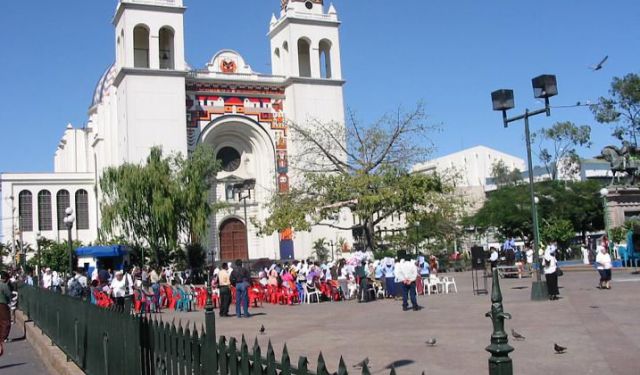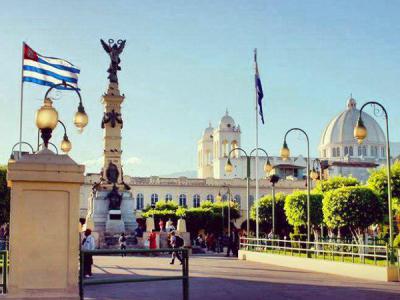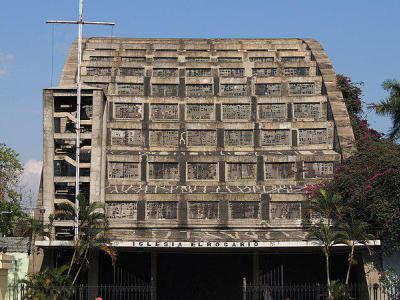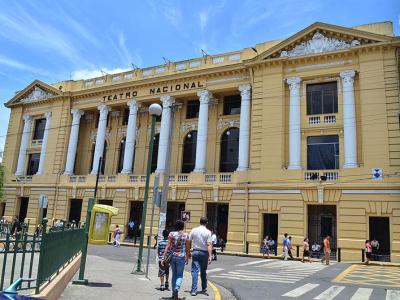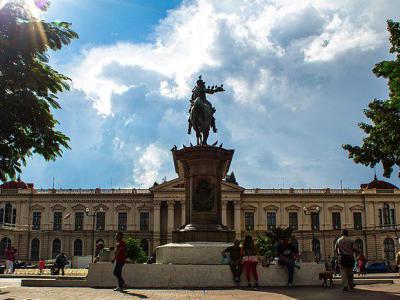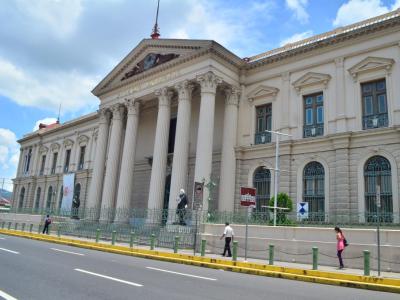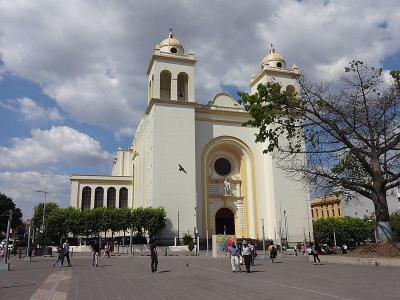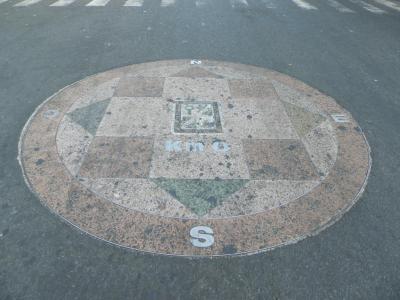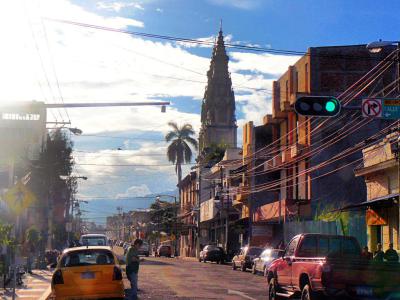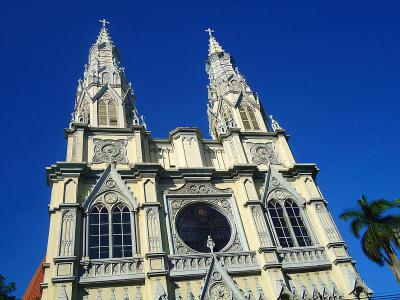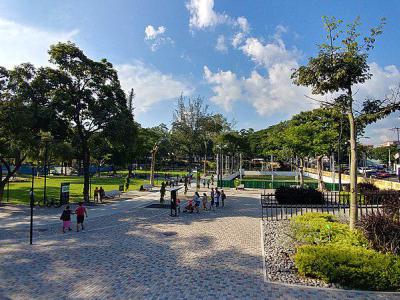San Salvador Introduction Walking Tour (Self Guided), San Salvador
The vibrant capital of El Salvador, San Salvador, weaves a colorful tapestry of history and culture as a testament to resilience and rebirth amid natural adversities. The city's name, translating to 'Holy Savior,' traces its origins to the Spanish conquest, epitomizing the deep religious roots instilled by the colonizers.
The region's history, however, dates back to the pre-Spanish indigenous confederation of Cuzcatlan established by the Pipil people, who later abandoned it to avoid Spanish conquest. The new settlers reoccupied and developed the area from 1525, relocating their colony twice due to seismic activity. Initially part of the Captaincy General of Guatemala, the town became El Salvador's capital in 1546 and was officially named so after the country's gaining independence in 1824.
Despite setbacks from earthquakes and political upheavals, including military coups, urban development accelerated in the 20th century. Recognized as a "Latin American capital of culture", San Salvador has managed to preserve its historical heritage and adapt to the modern era, offering a unique blend of past and present.
The city saw halted modernization during the civil war but has recently focused on revitalizing the Old Town area, central to its historic core. Celebrated for its unique heritage, El Salvador's capital hosts architectural marvels not commonly found in Latin America. Key local landmarks include the Metropolitan Cathedral, combining Baroque and eclectic styles from the 1950s, and the 1905 National Palace, blending Gothic, Neoclassical, and Renaissance Revival architecture. The National Theater, Central America's oldest, showcases French Renaissance Revival architecture with Rococo, Romantic, and Art Nouveau details, and seats 650 spectators beneath an ornate dome.
Among other notable landmarks is Plaza Libertad, a significant site that marks the birthplace of Salvadoran independence. This square is surrounded by historic buildings, including the distinctive Rosary Church (Iglesia El Rosario) that stands out with its unconventional modernist design, offering a stark contrast to the traditional baroque styles dominating the region. Not far off, the imposing Metropolitan Cathedral is a site of both religious devotion and social activism.
San Salvador is a city of contrasts and continuities, where the past is not only remembered but also celebrated. Take this self-guided tour to discover the stories embedded in the city's landmarks and immerse yourself in its dynamic atmosphere. Come and witness the enduring spirit of the 'Holy Savior'-a city that both honors its roots and embraces the future.
The region's history, however, dates back to the pre-Spanish indigenous confederation of Cuzcatlan established by the Pipil people, who later abandoned it to avoid Spanish conquest. The new settlers reoccupied and developed the area from 1525, relocating their colony twice due to seismic activity. Initially part of the Captaincy General of Guatemala, the town became El Salvador's capital in 1546 and was officially named so after the country's gaining independence in 1824.
Despite setbacks from earthquakes and political upheavals, including military coups, urban development accelerated in the 20th century. Recognized as a "Latin American capital of culture", San Salvador has managed to preserve its historical heritage and adapt to the modern era, offering a unique blend of past and present.
The city saw halted modernization during the civil war but has recently focused on revitalizing the Old Town area, central to its historic core. Celebrated for its unique heritage, El Salvador's capital hosts architectural marvels not commonly found in Latin America. Key local landmarks include the Metropolitan Cathedral, combining Baroque and eclectic styles from the 1950s, and the 1905 National Palace, blending Gothic, Neoclassical, and Renaissance Revival architecture. The National Theater, Central America's oldest, showcases French Renaissance Revival architecture with Rococo, Romantic, and Art Nouveau details, and seats 650 spectators beneath an ornate dome.
Among other notable landmarks is Plaza Libertad, a significant site that marks the birthplace of Salvadoran independence. This square is surrounded by historic buildings, including the distinctive Rosary Church (Iglesia El Rosario) that stands out with its unconventional modernist design, offering a stark contrast to the traditional baroque styles dominating the region. Not far off, the imposing Metropolitan Cathedral is a site of both religious devotion and social activism.
San Salvador is a city of contrasts and continuities, where the past is not only remembered but also celebrated. Take this self-guided tour to discover the stories embedded in the city's landmarks and immerse yourself in its dynamic atmosphere. Come and witness the enduring spirit of the 'Holy Savior'-a city that both honors its roots and embraces the future.
How it works: Download the app "GPSmyCity: Walks in 1K+ Cities" from Apple App Store or Google Play Store to your mobile phone or tablet. The app turns your mobile device into a personal tour guide and its built-in GPS navigation functions guide you from one tour stop to next. The app works offline, so no data plan is needed when traveling abroad.
San Salvador Introduction Walking Tour Map
Guide Name: San Salvador Introduction Walking Tour
Guide Location: El Salvador » San Salvador (See other walking tours in San Salvador)
Guide Type: Self-guided Walking Tour (Sightseeing)
# of Attractions: 10
Tour Duration: 2 Hour(s)
Travel Distance: 2.7 Km or 1.7 Miles
Author: jenny
Sight(s) Featured in This Guide:
Guide Location: El Salvador » San Salvador (See other walking tours in San Salvador)
Guide Type: Self-guided Walking Tour (Sightseeing)
# of Attractions: 10
Tour Duration: 2 Hour(s)
Travel Distance: 2.7 Km or 1.7 Miles
Author: jenny
Sight(s) Featured in This Guide:
- Plaza Libertad (Liberty Square)
- Iglesia El Rosario (Rosary Church)
- Teatro Nacional (National Theatre)
- Plaza Gerardo Barrios (Gerardo Barrios Square)
- El Palacio Nacional (National Palace of El Salvador)
- Metropolitan Cathedral
- Kilometro Cero (Kilometer Zero)
- Calle Arce (Arce Street)
- Basilica Sagrado Corazon (Basilica of the Sacred Heart of Jesus)
- Parque Cuscatlan (Cuscatlan Park)
1) Plaza Libertad (Liberty Square) (must see)
Liberty Square holds immense historical and archaeological significance. This square is considered the starting point of the city's history and, by extension, the history of the Salvadoran people. With its rich architectural design and European heritage, Libertad Square serves as a vibrant cultural hub offering a variety of entertainment, gastronomy, and activities. Visitors can experience live shows in the square and explore the surrounding buildings, each with its own unique charm and historical value.
The centerpiece of Libertad Square is the statue of Liberty, from which the square derives its name. This monument commemorates one of the most pivotal events in Central America's history: the independence of the region in 1811. The statue stands as a symbol of freedom and resilience, marking the nation's journey towards independence. Its location in the heart of San Salvador makes it a significant landmark, not just for its historical importance but also as a focal point for both locals and tourists.
The square provides a perfect setting for a leisurely walk or a relaxing afternoon with family and friends. Its serene atmosphere and historical ambiance make it an ideal spot for spending quality time, whether you're soaking in the cultural heritage or simply enjoying the vibrant city life.
The centerpiece of Libertad Square is the statue of Liberty, from which the square derives its name. This monument commemorates one of the most pivotal events in Central America's history: the independence of the region in 1811. The statue stands as a symbol of freedom and resilience, marking the nation's journey towards independence. Its location in the heart of San Salvador makes it a significant landmark, not just for its historical importance but also as a focal point for both locals and tourists.
The square provides a perfect setting for a leisurely walk or a relaxing afternoon with family and friends. Its serene atmosphere and historical ambiance make it an ideal spot for spending quality time, whether you're soaking in the cultural heritage or simply enjoying the vibrant city life.
2) Iglesia El Rosario (Rosary Church) (must see)
Rosary Church, completed in 1971, is a distinctive and beautiful church located near San Salvador's main cathedral. Designed by Salvadoran architect Rubén Martínez, this church stands out for its unique architecture and serene atmosphere.
One of the most captivating aspects of Rosary Church is its windows and the way they play with interior light. The design allows natural light to filter through in a way that creates a tranquil and spiritual ambiance, perfect for prayer and contemplation. This use of light and space sets the church apart from other religious buildings in the area, offering visitors a unique sensory experience.
The church also incorporates elements of European architectural style, making it one of the last churches in El Salvador to do so. This blend of local and European influences is evident in the church's structure and design details. One of the most striking features inside the church is the iron sculpture of Christ on the cross, located at the altar. This sculpture adds to the church's solemn and reflective atmosphere, inviting visitors to pause and reflect.
One of the most captivating aspects of Rosary Church is its windows and the way they play with interior light. The design allows natural light to filter through in a way that creates a tranquil and spiritual ambiance, perfect for prayer and contemplation. This use of light and space sets the church apart from other religious buildings in the area, offering visitors a unique sensory experience.
The church also incorporates elements of European architectural style, making it one of the last churches in El Salvador to do so. This blend of local and European influences is evident in the church's structure and design details. One of the most striking features inside the church is the iron sculpture of Christ on the cross, located at the altar. This sculpture adds to the church's solemn and reflective atmosphere, inviting visitors to pause and reflect.
3) Teatro Nacional (National Theatre)
The National Theatre of El Salvador holds the prestigious title of being the oldest theatre in Central America. Construction began on November 3, 1911, under the guidance of French architect Daniel Beylard and was completed on March 1, 1917. The theatre showcases a French Renaissance style infused with modern elements, making it a significant architectural landmark. The Italian architect Lucio Capellaro contributed to the decoration, ensuring the Great Hall remains one of the most beautiful and elegant spaces in Central America.
The theatre’s design is a rich blend of multiple architectural styles, including Versailles Style, Rococo, Romanticism, and Art Nouveau, with regional touches that reflect the cultural heritage of El Salvador. This fusion of styles is evident in the intricate details and grandiose aesthetic of the building. The furniture inside the theatre was partly crafted in its own workshop, with additional furnishings, rugs, carpets, armchairs, and lecterns imported from the United States, adding to the theatre's luxurious interior.
After 59 years of continuous use, the theatre underwent a significant remodeling process in 1976, funded by the Salvadoran government. This renovation aimed to preserve the theatre’s historical essence while updating its facilities to meet modern standards. The careful restoration ensured that the theatre retained its original charm and elegance, continuing to serve as a cultural hub for the arts.
Today, the National Theatre of El Salvador stands as a testament to the country’s rich cultural history and architectural innovation. It remains a central venue for performances and events, attracting both locals and tourists who appreciate its historical significance and stunning design.
The theatre’s design is a rich blend of multiple architectural styles, including Versailles Style, Rococo, Romanticism, and Art Nouveau, with regional touches that reflect the cultural heritage of El Salvador. This fusion of styles is evident in the intricate details and grandiose aesthetic of the building. The furniture inside the theatre was partly crafted in its own workshop, with additional furnishings, rugs, carpets, armchairs, and lecterns imported from the United States, adding to the theatre's luxurious interior.
After 59 years of continuous use, the theatre underwent a significant remodeling process in 1976, funded by the Salvadoran government. This renovation aimed to preserve the theatre’s historical essence while updating its facilities to meet modern standards. The careful restoration ensured that the theatre retained its original charm and elegance, continuing to serve as a cultural hub for the arts.
Today, the National Theatre of El Salvador stands as a testament to the country’s rich cultural history and architectural innovation. It remains a central venue for performances and events, attracting both locals and tourists who appreciate its historical significance and stunning design.
4) Plaza Gerardo Barrios (Gerardo Barrios Square)
The historic Gerardo Barrios Square has been the backdrop for numerous important events in the nation's history. It has hosted the funerals of prominent figures such as Archbishop Oscar Romero and marked the end of the Salvadoran Civil War in 1992. Today, it continues to be a vibrant center for public life, hosting concerts, exhibitions, celebrations of the patron saint of San Salvador, various Masses, and parades.
The square was designed by brothers Antonio and Carlos Ezeta and features a prominent statue of Gerardo Barrios, a national hero and former president of El Salvador. This statue serves as a focal point in the square, symbolizing the country’s pride and resilience. The square's design and layout reflect the historical and cultural heritage of San Salvador, making it a popular destination for both locals and tourists.
Surrounded by significant buildings such as the Metropolitan Cathedral and the National Palace, Plaza Gerardo Barrios is not only a center for public events but also a place of architectural and historical interest. The Metropolitan Cathedral, with its impressive façade and rich history, and the National Palace, an architectural marvel, provide a picturesque backdrop to the square, enhancing its cultural significance.
The square was designed by brothers Antonio and Carlos Ezeta and features a prominent statue of Gerardo Barrios, a national hero and former president of El Salvador. This statue serves as a focal point in the square, symbolizing the country’s pride and resilience. The square's design and layout reflect the historical and cultural heritage of San Salvador, making it a popular destination for both locals and tourists.
Surrounded by significant buildings such as the Metropolitan Cathedral and the National Palace, Plaza Gerardo Barrios is not only a center for public events but also a place of architectural and historical interest. The Metropolitan Cathedral, with its impressive façade and rich history, and the National Palace, an architectural marvel, provide a picturesque backdrop to the square, enhancing its cultural significance.
5) El Palacio Nacional (National Palace of El Salvador)
The National Palace of El Salvador, located in the heart of San Salvador, stands as a monument of immense historical significance. Once serving as the seat of the country's government, it ceased this function after being damaged by earthquakes. Despite this, the palace remains an important historical site and is now open to tourists. Built in the early 20th century, its architectural style is a blend of Italian design with neo-Renaissance elements, reflecting European influences. The opulent interior, adorned with luxurious decorations, earned it the status of a national monument in 1974, making it one of the most representative buildings in the country.
The current structure replaced the old National Palace, which was built between 1866 and 1870 but was destroyed by fire in 1889. Construction of the new palace began in 1905 and was completed in 1911 under the supervision of engineer José Emilio Alcaine and foreman Pascasio González Erazo. To fund the construction, legislation was enacted to collect one colón for every quintal of coffee exported. The materials for the palace were imported from various European countries, including Germany, Italy, and Belgium, showcasing a rich array of imported craftsmanship and materials.
The National Palace's interior is notable for its four main rooms and 101 secondary rooms, each main room distinguished by a unique color. The Red Room (Salon Rojo) is used for receptions by the Salvadoran Foreign Ministry and ceremonial presentations of ambassadors' credentials, a tradition since the administration of General Maximiliano Hernández Martínez. The Yellow Room (Salon Amarillo) serves as the office for the President of the Republic. The Pink Room (Salon Rosado) originally housed the Supreme Court and later the Ministry of Defense.
The Blue Room (Salon Azul) was the meeting place of the Legislature of El Salvador from 1906, notable for its classical architecture with Ionian, Corinthian, and Roman elements. This room, now called the Salvadoran Parliament, commemorates its historical purpose and was declared a National Historic Landmark in 1974.
Today, the National Palace of El Salvador stands not only as a testament to the country's rich history but also as a symbol of its architectural and cultural heritage. Visitors can explore its grand halls and intricate designs, gaining insight into the historical and political legacy of El Salvador.
The current structure replaced the old National Palace, which was built between 1866 and 1870 but was destroyed by fire in 1889. Construction of the new palace began in 1905 and was completed in 1911 under the supervision of engineer José Emilio Alcaine and foreman Pascasio González Erazo. To fund the construction, legislation was enacted to collect one colón for every quintal of coffee exported. The materials for the palace were imported from various European countries, including Germany, Italy, and Belgium, showcasing a rich array of imported craftsmanship and materials.
The National Palace's interior is notable for its four main rooms and 101 secondary rooms, each main room distinguished by a unique color. The Red Room (Salon Rojo) is used for receptions by the Salvadoran Foreign Ministry and ceremonial presentations of ambassadors' credentials, a tradition since the administration of General Maximiliano Hernández Martínez. The Yellow Room (Salon Amarillo) serves as the office for the President of the Republic. The Pink Room (Salon Rosado) originally housed the Supreme Court and later the Ministry of Defense.
The Blue Room (Salon Azul) was the meeting place of the Legislature of El Salvador from 1906, notable for its classical architecture with Ionian, Corinthian, and Roman elements. This room, now called the Salvadoran Parliament, commemorates its historical purpose and was declared a National Historic Landmark in 1974.
Today, the National Palace of El Salvador stands not only as a testament to the country's rich history but also as a symbol of its architectural and cultural heritage. Visitors can explore its grand halls and intricate designs, gaining insight into the historical and political legacy of El Salvador.
6) Metropolitan Cathedral (must see)
The Metropolitan Cathedral of the Holy Savior is the principal church of the Roman Catholic Archdiocese of San Salvador and the seat of the Archbishop. The cathedral holds deep significance for the Salvadoran people, having been twice visited by Pope John Paul II, who remarked on its close connection with the nation's joys and hopes. The site where the cathedral now stands was once home to the old Temple of Santo Domingo. It bears a poignant history, particularly marked by the tragic events of Palm Sunday, March 31, 1980, when 44 people were killed during the funeral of Archbishop Romero due to gunfire on the worshipers and the funeral cortege. This event left an indelible mark on the cathedral's legacy.
The square in front of the Metropolitan Cathedral also witnessed the euphoric celebrations following the signing of the Chapultepec Peace Accords in 1992, which ended the Salvadoran Civil War. The current cathedral structure was completed and inaugurated on March 19, 1999. Its festive tiled facade, designed by Salvadoran master Fernando Llort, adds a vibrant and colorful touch to the building, reflecting the cultural and artistic heritage of El Salvador.
Inside the cathedral, the main altar is a focal point, featuring an image of the Divine Saviour of the World, sculpted by Friar Francisco Silvestre García in 1777. This image, donated by Holy Roman Emperor Charles V in 1546, rests on a four-column baldacchino surrounded by statues of the prophets Moses and Elijah, who are integral to the Transfiguration story. The main altar is further adorned with eight large paintings depicting scenes from the life of Christ, created by Andrés García Ibáñez, adding to the cathedral's artistic and spiritual ambiance.
Crowning the cathedral is a bright Churrigueresque cupola, enhancing the grandeur of the structure. The Metropolitan Cathedral of the Holy Savior stands as a symbol of faith, resilience, and hope for the Salvadoran people, embodying both their historical struggles and their enduring spirit. Visitors and worshipers alike are drawn to its rich history, artistic beauty, and the profound sense of community it represents.
The square in front of the Metropolitan Cathedral also witnessed the euphoric celebrations following the signing of the Chapultepec Peace Accords in 1992, which ended the Salvadoran Civil War. The current cathedral structure was completed and inaugurated on March 19, 1999. Its festive tiled facade, designed by Salvadoran master Fernando Llort, adds a vibrant and colorful touch to the building, reflecting the cultural and artistic heritage of El Salvador.
Inside the cathedral, the main altar is a focal point, featuring an image of the Divine Saviour of the World, sculpted by Friar Francisco Silvestre García in 1777. This image, donated by Holy Roman Emperor Charles V in 1546, rests on a four-column baldacchino surrounded by statues of the prophets Moses and Elijah, who are integral to the Transfiguration story. The main altar is further adorned with eight large paintings depicting scenes from the life of Christ, created by Andrés García Ibáñez, adding to the cathedral's artistic and spiritual ambiance.
Crowning the cathedral is a bright Churrigueresque cupola, enhancing the grandeur of the structure. The Metropolitan Cathedral of the Holy Savior stands as a symbol of faith, resilience, and hope for the Salvadoran people, embodying both their historical struggles and their enduring spirit. Visitors and worshipers alike are drawn to its rich history, artistic beauty, and the profound sense of community it represents.
7) Kilometro Cero (Kilometer Zero)
Kilometer Zero is a significant emblem in San Salvador, marking the central point from which all distances in the national territory are measured. On February 21, 2024, the San Salvador mayor's staff placed the new "Kilometer Zero" emblem in the Historic Center of the capital. This installation is a part of the Revitalization Plan spearheaded by Mayor Mario Durán, aimed at rejuvenating the heart of the city.
The ongoing construction work on the Downtown Urban Corridor includes the modernization of Kilometer Zero. This involves the placement of a stainless steel and bronze plate with a diameter of 3 meters. The plate is embedded in hammered concrete, which not only provides a non-slip surface but also adds a rustic and original appearance to the emblem.
Kilometer Zero is not just a geographical marker but a historical symbol representing the point from which the expansion of San Salvador began. The revitalization of Kilometer Zero is a part of broader efforts to modernize and beautify San Salvador's Historic Center, making it a more attractive and functional space for residents and visitors alike.
The ongoing construction work on the Downtown Urban Corridor includes the modernization of Kilometer Zero. This involves the placement of a stainless steel and bronze plate with a diameter of 3 meters. The plate is embedded in hammered concrete, which not only provides a non-slip surface but also adds a rustic and original appearance to the emblem.
Kilometer Zero is not just a geographical marker but a historical symbol representing the point from which the expansion of San Salvador began. The revitalization of Kilometer Zero is a part of broader efforts to modernize and beautify San Salvador's Historic Center, making it a more attractive and functional space for residents and visitors alike.
8) Calle Arce (Arce Street)
Arce Street, named after General José Manuel Arce, the first president of the Federal Republic of Central America, is a major historical thoroughfare in San Salvador. In a significant urban renewal effort, this important street was transformed into a pedestrian-only mall to revitalize the historic downtown area. Mayor Norman Quijano inaugurated the first phase of this redevelopment near the Plaza de la Salud, focusing on enhancing the pedestrian experience and preserving the street's historical charm.
The initial phase of the redevelopment included improvements to the sidewalks between 21st and 19th Avenida Norte. These enhancements aimed to create a more inviting and accessible environment for both locals and visitors. The installation of twelve antique lights, originally from Spain and dating back to 1900, adds a touch of historical elegance to the street.
In addition to the antique lights, the redevelopment project incorporated six benches and forty trees along Arce Street. The greenery and seating options encourage people to spend more time outdoors, fostering a sense of community and enhancing the vibrancy of the historic downtown.
The transformation of Arce Street into a pedestrian-only mall reflects San Salvador's commitment to preserving its historical legacy while promoting urban renewal. By creating a space that prioritizes pedestrians and highlights the street's historical significance, the city has successfully blended the past with the present.
The initial phase of the redevelopment included improvements to the sidewalks between 21st and 19th Avenida Norte. These enhancements aimed to create a more inviting and accessible environment for both locals and visitors. The installation of twelve antique lights, originally from Spain and dating back to 1900, adds a touch of historical elegance to the street.
In addition to the antique lights, the redevelopment project incorporated six benches and forty trees along Arce Street. The greenery and seating options encourage people to spend more time outdoors, fostering a sense of community and enhancing the vibrancy of the historic downtown.
The transformation of Arce Street into a pedestrian-only mall reflects San Salvador's commitment to preserving its historical legacy while promoting urban renewal. By creating a space that prioritizes pedestrians and highlights the street's historical significance, the city has successfully blended the past with the present.
9) Basilica Sagrado Corazon (Basilica of the Sacred Heart of Jesus)
The Basilica of the Sacred Heart of Jesus, a centennial parish built in 1913, is one of San Salvador's most cherished religious landmarks. This basilica, which took two decades to complete, showcases a blend of architectural styles, reflecting the varied influences of the time. Upon entering the church, visitors are immediately enveloped in an atmosphere of prayer and fraternity, resonating with the deep sense of community among its parishioners.
Known as the most beautiful religious building in El Salvador, the Basilica of the Sacred Heart of Jesus is constructed primarily from wood and metal, materials that were prevalent during its construction period. Despite its elegance, the basilica has faced significant challenges over the years, enduring five major earthquakes from its inception until 2001. These natural disasters necessitated multiple restorations to preserve its structural integrity and aesthetic charm.
In 1989, the basilica temporarily assumed the role of the main church in San Salvador while the principal cathedral was undergoing reconstruction. This period further cemented its importance in the spiritual and cultural life of the city. The resilience of the Basilica of the Sacred Heart of Jesus, surviving numerous earthquakes and restorations, stands as a testament to its enduring significance and the unwavering faith of its congregation.
Known as the most beautiful religious building in El Salvador, the Basilica of the Sacred Heart of Jesus is constructed primarily from wood and metal, materials that were prevalent during its construction period. Despite its elegance, the basilica has faced significant challenges over the years, enduring five major earthquakes from its inception until 2001. These natural disasters necessitated multiple restorations to preserve its structural integrity and aesthetic charm.
In 1989, the basilica temporarily assumed the role of the main church in San Salvador while the principal cathedral was undergoing reconstruction. This period further cemented its importance in the spiritual and cultural life of the city. The resilience of the Basilica of the Sacred Heart of Jesus, surviving numerous earthquakes and restorations, stands as a testament to its enduring significance and the unwavering faith of its congregation.
10) Parque Cuscatlan (Cuscatlan Park)
Cuscatlan Park is a cherished green space in San Salvador, offering a relaxing atmosphere for visitors seeking respite from the bustling city. Its convenient location makes it one of the most popular spots for both locals and tourists. The park is not just a place for leisure but also a site of significant historical and cultural interest.
One of the park's most notable features is the Monumento a la Memoria y la Verdad, an 85-meter-long granite wall inscribed with the names of those who were killed during the turbulent 1970s. This monument, inaugurated in 2003 by a committee dedicated to honoring civil victims, serves as a poignant reminder of the country's past and a tribute to the lives lost during that era. It stands as a solemn yet powerful testament to El Salvador's history and the resilience of its people.
In addition to the historical monument, Cuscatlan Park is surrounded by important cultural institutions. The Tin Marín Children's Museum, located nearby, offers engaging exhibits and activities for younger visitors, making the park a great family destination. The Sala Nacional de Exposiciones, also in close proximity, presents exhibitions of contemporary art, enriching the cultural experience for park-goers.
One of the park's most notable features is the Monumento a la Memoria y la Verdad, an 85-meter-long granite wall inscribed with the names of those who were killed during the turbulent 1970s. This monument, inaugurated in 2003 by a committee dedicated to honoring civil victims, serves as a poignant reminder of the country's past and a tribute to the lives lost during that era. It stands as a solemn yet powerful testament to El Salvador's history and the resilience of its people.
In addition to the historical monument, Cuscatlan Park is surrounded by important cultural institutions. The Tin Marín Children's Museum, located nearby, offers engaging exhibits and activities for younger visitors, making the park a great family destination. The Sala Nacional de Exposiciones, also in close proximity, presents exhibitions of contemporary art, enriching the cultural experience for park-goers.
The Most Popular Cities
/ view all
